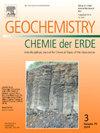柯曼新生代岩浆弧Kuh-e-Kapout铜斑岩矿床斑岩指示矿物矿物化学特征:成因及找矿意义
IF 2.9
3区 地球科学
Q2 GEOCHEMISTRY & GEOPHYSICS
引用次数: 0
摘要
Kuh-e-Kapout斑岩铜矿位于Jebal-Barez地区Kerman新生代岩浆弧南端。本文首次对该矿床与斑岩成矿有关的岩浆-热液系统的演化及成因进行了研究。该矿床受jebal - barez型花岗岩类的影响,在PCDs中表现出弱矿化特征。使用诸如斑岩指示矿物之类的工具可以帮助识别导致该矿床成矿的过程。以黑云母、斜长石和角闪孔为指示矿物的电子探针显微分析数据,确定了与成矿有关的热液-岩浆系统的物理化学条件。矿床赋存于一个与弧相关的浅钙碱性侵入杂岩中,其成分为石英闪长岩。在岩心研究中,中心部位表现出与铜硫化物矿化脉相关的钾蚀变,其中包括热液黑云母和钾长石的富钾相,取代了原生镁铁矿物。这一蚀变转变为层状叠加带,其特征是长石绢云母化增加,石英±黄铁矿±黄铜矿脉多存在。在岩心上部,以细粒硫化物、绢云母和萤石为标志,显示出超前的泥质蚀变。未矿化微闪长岩脉侵入的叶状蚀变带内的石英闪长岩。石英闪长岩和微闪长岩中指示矿物的研究,特别是石英闪长岩侵入中钾成矿带的指示矿物的研究,揭示了成矿条件的物理化学条件:在辉云母田中绘制了Fe/(Fe + Mg)-AlIV图上的黑云母,显示为Mg-黑云母类型,与i型花岗岩类相关联。这些资料显示了具有矿化性质的石英闪长岩的幔壳混合源。石英闪长岩和微闪长斑岩的地球化学特征显示出钙碱性亲和作用,与俯冲相关造山作用有关。根据黑云母和角闪孔地球化学特征,估计岩浆活动的氧逸度分别具有高(HM)至中等(NNO)特征。基于黑云母地球化学的log f(H2O)/f(HF) >; 1和log f(H2O)/f(HCl) >; 1表明矿化流体相对富水。石英闪长岩和微闪长岩的斜长石在Na2O + K2O + CaO (wt%)-SiO2图上的数据点位于钙长岩和钠长岩之间。这些资料中的过量铝不是蚀变的结果,而是由高PH2O岩浆引起的。黑云母化学表明,石英闪长岩岩浆成矿作用发生在钾蚀变带一个相对封闭的体系内。矿化呈藤蔓状,以黄铜矿和黄铁矿为主。在成矿条件和物理化学推断结果方面,分析样品的黑云母化学与UDMA其他肥沃矿床的黑云母化学结果一致。总的来说,本研究的硅酸盐地球化学特征表明Kuh-e-Kapout岩浆-热液系统的物理化学性质与其他UDMA铜斑岩矿床相似。本文章由计算机程序翻译,如有差异,请以英文原文为准。
Mineral chemistry of porphyry indicator minerals in Kuh-e-Kapout Cu porphyry deposit, Kerman Cenozoic Magmatic Arc: Petrogenetic and exploration implications
The Kuh-e-Kapout porphyry copper deposit is located at the south end of the Kerman Cenozoic Magmatic Arc in the Jebal-Barez area. This article presents a first-time study on the evolution and origin of the magmatic-hydrothermal system associated with porphyry mineralization in this deposit. This deposit is affected by Jebal-Barez-type granitoids, which exhibit weak mineralization properties in PCDs. Using tools such as porphyry indicator minerals can help recognize the process that led to mineralization in this deposit. Based on electron probe micro-analyzer data from Biotite, plagioclase, and amphibole as indicator minerals, the physicochemical conditions of the hydrothermal-magmatic system associated with mineralization have been determined. This deposit is hosted in an arc-related, shallow calc-alkaline intrusive complex with a quartz diorite composition. In the study of drill cores, the central parts exhibit potassic alteration linked to copper sulfide mineralization veins, which includes potassium-rich phases of hydrothermal biotite and potassium feldspar that replace primary ferromagnesian minerals. This alteration transitions into a superimposed phyllic zone, characterized by increased sericitization of feldspars and mostly the presence of quartz±pyrite±Chalcopyrite veins. In the upper parts of the drill cores, advanced argillic alteration is indicated by fine-grained sulfides, sericite, and fluorite. Quartz diorite in the phyllic alteration zone intruded by an unmineralized microdiorite dike. Research on indicator minerals in quartz diorite and microdiorite, particularly in the potassic mineralizing zone in quartz diorite intrusion, provided insights into the physicochemical conditions of ore formation condition: biotites on the Fe/(Fe + Mg)-AlIV diagram are plotted in the phlogopite field, indicating the Mg-biotite type, which is associated with I-type granitoid. These data show the mantle-crust mixture source for quartz diorite with mineralized properties. Biotite and calcic amphibole geochemistry exhibiting calc-alkaline affinity with subduction-related orogeny for the quartz diorite and microdiorite porphyries. Based on biotite and amphibole geochemistry, the oxygen fugacity of the magmatism is estimated to have a range of high (HM) to moderate (NNO) characteristics, respectively. The ratio of log f(H2O)/f(HF) > 1 and log f(H2O)/ f(HCl) > 1 based on biotite geochemistry indicates the mineralized fluid was relatively water-rich. Data points of Plagioclase from quartz diorite and microdiorite plotted on the Na2O + K2O + CaO (wt%)-SiO2 diagram, are between anorthite and albite. The excess Al in these data does not result from alteration and resulted from a magma with high PH2O. Biotite chemistry indicates that mineralization in the quartz diorite magmatism occurred within a relatively closed system in the potassic alteration zone. Mineralization was observed as vines with a predominance of chalcopyrite and pyrite. The biotite chemistry from the analyzed samples is in good agreement with the results of biotite chemistry from other fertile deposits in UDMA, in terms of mineralization conditions and physicochemical inferred results. Generally, the silicate geochemistry in this study indicates physicochemical attributes of the Kuh-e-Kapout magmatic-hydrothermal system similar to those of other UDMA Cu porphyry deposits.
求助全文
通过发布文献求助,成功后即可免费获取论文全文。
去求助
来源期刊

Chemie Der Erde-Geochemistry
地学-地球化学与地球物理
CiteScore
7.10
自引率
0.00%
发文量
40
审稿时长
3.0 months
期刊介绍:
GEOCHEMISTRY was founded as Chemie der Erde 1914 in Jena, and, hence, is one of the oldest journals for geochemistry-related topics.
GEOCHEMISTRY (formerly Chemie der Erde / Geochemistry) publishes original research papers, short communications, reviews of selected topics, and high-class invited review articles addressed at broad geosciences audience. Publications dealing with interdisciplinary questions are particularly welcome. Young scientists are especially encouraged to submit their work. Contributions will be published exclusively in English. The journal, through very personalized consultation and its worldwide distribution, offers entry into the world of international scientific communication, and promotes interdisciplinary discussion on chemical problems in a broad spectrum of geosciences.
The following topics are covered by the expertise of the members of the editorial board (see below):
-cosmochemistry, meteoritics-
igneous, metamorphic, and sedimentary petrology-
volcanology-
low & high temperature geochemistry-
experimental - theoretical - field related studies-
mineralogy - crystallography-
environmental geosciences-
archaeometry
 求助内容:
求助内容: 应助结果提醒方式:
应助结果提醒方式:


